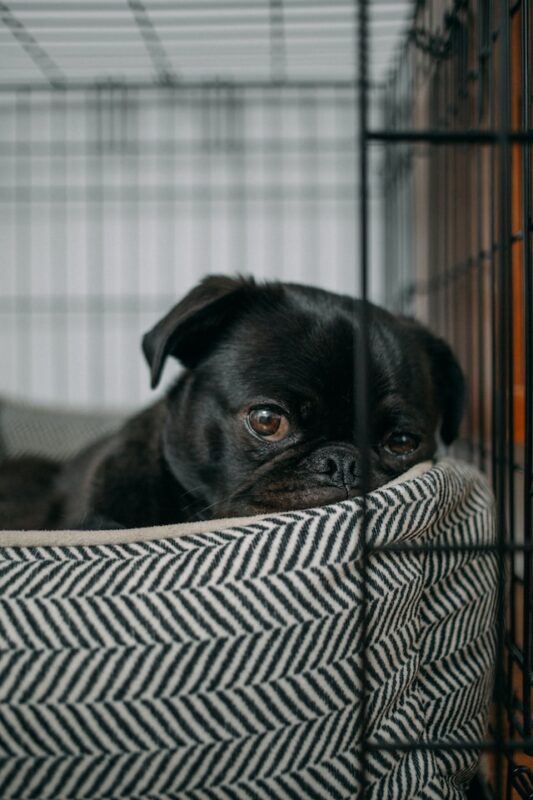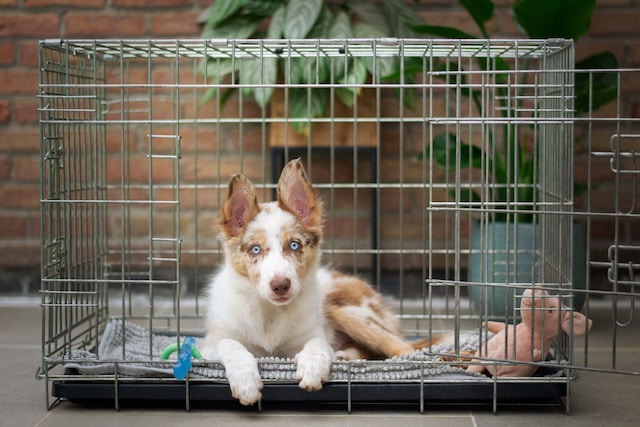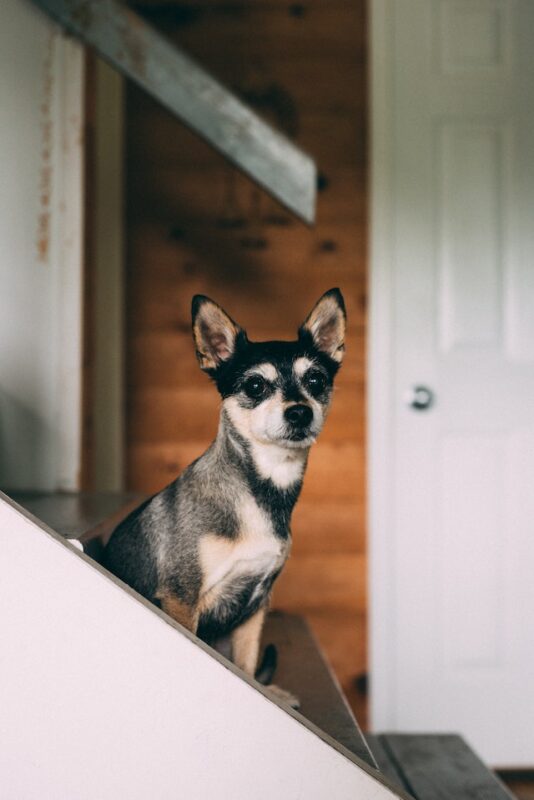Crating a Dog with Separation Anxiety: Is it a Good Idea?
Posted: 06/27/2023 | BY: Jenna Bruce | Categories: Behavior , Dog , Pet care
Do you have a dog that struggles with separation anxiety? Watching your dog suffer from being alone is not only sad, it can also be a bit frustrating because of course there will be those times when you must leave the house. Many pup parents wonder if crating a dog with separation anxiety is a good idea. Will it actually help or make matters worse? That’s the question we’ll explore in this blog post.

Can Crate Training a Dog with Separation Anxiety be Beneficial?
In order to answer this question thoughtfully, we first need to explore what separation anxiety is and why dogs develop it in the first place.
Dogs are Pack Animals
Our dogs want to be with us at all times. They are pack animals and feel secure when they are part of their group. In the wild, a dog on its own may become prey for another larger animal. So when your dog is left alone, their DNA and ancestral survivor instincts kick in. It is simply not natural for dogs to be left alone for long periods of time. They are social creatures and have a deep need to be part of a group.
Having said this, you can train a dog to be okay with being left home alone. This training needs to be conducted in just the right way and happen in puppyhood. The problem is, many people adopt older dogs who have either not had this training or who were rescued off the street. Rescue dogs have sustained real trauma from being alone and feeling unsafe and insecure for the first part of their lives. These dogs will be prone to developing separation anxiety.
What Does Anxiety Look Like in Dogs?
A dog that is experiencing anxiety will basically look like they are having a panic attack whenever their human(s) are getting ready to leave the house. They may whine and pace. Some begin to drool and pant. It’s awful.
Crates can be helpful because they restrict your dog’s ability to pace. When a dog is moving around in a state of panic, sometimes the very act of moving obsessively can make him even more anxious. So crating a dog can be helpful in decreasing the ability to move.
It’s very important to mention…
You can’t just shove a dog with separation anxiety into a crate and hope that that will solve all your problems. A create in and of itself is not a magic bullet that will kill the anxiety. If your dog doesn’t see their crate as a safe space, it will in fact only make matters worse. In fact, your pup could become seriously injured in their crate if they end up having a panic attack while inside.
This happens more than you think. When a pup parents crates their anxious dog who is new to being in a crate they often come home to a dog that has a bloody nose, mouth and paws, as their poor dog has felt trapped and tried to chew and claw their way out of the crate.

Tips for Crating a Dog with Separation Anxiety
Before you decide to crate train your dog, be certain that this is the very best option for him. Speak with your vet to get her thoughts. Sometimes dogs with anxiety simply need more exercise. Some can be calmed using products like CBD oil or DAP, a synthetic pheromone that mimics a mother’s pheromones she secretes to soothe her young puppies. And sometimes a prescription medication can be given on an as-needed basis to help put your pup at ease while you’re away.
Should you and your vet decide that crating is the best approach to help your pup, then the following are some tips to ensure crating is a positive experience for your fur baby:
Choose the Right Crate
You’ve got to make sure the crate you choose is the right size for your dog. They need enough space to move around a little bit. Be sure it’s big enough so they can stand and turn in a full circle without bumping into the sides or top. It also needs to be big enough to house their water bowl station. NEVER leave a dog alone in a crate for hours without water!
The material of the crate is also important to consider. Wire and mesh crates are popular but dogs with separation anxiety will most likely chew right through these crates and get hurt at the same time. There are many nice, large plastic crates that have proper ventilation but are more private and cozy. These tend to work best.
And finally, you’ll need to make the crate cozy and comfortable. Be sure to put your dog’s regular bed in there so he can snuggle in. If he doesn’t have a regular bed or it’s too big to fit, then fold up some blankets so it’s nice and padded. Many crates these days also come with a bottom pad to help make it more comfortable for your pup.
Let Your Dog Get Used to His New Crate
Again, you can’t just buy a crate, make it cozy, and then put your dog in it for hours and hope for the best. You’ll need to take some time and allow your dog to get used to it and see it as a space they want to go to.
Many pup parents set the crate up permanently in their living room or home office and allow the pup to go in and out of it anytime they want. Make the space a positive one for them. When introducing it, put some treats in there. Do this every day for a few days so your dog begins to see the crate as a place where great things happen. After a few days of this, place them in the crate and shut the door. Do not leave the room. Simply stay in the room and do something (fold laundry etc.) in view of your dog. After a few moments, let them out of the crate.
Repeat This Exercise
Do this same exercise for about a week. Place your dog in the crate with some treats or his nylabone and close the door. Stay in the room and putter around, each time doing it a bit longer and longer so by the end of the week, he is in his crate with you in the room for 15-20 minutes.

Train with Verbal Cues
Now it’s time to start leaving the room and using some verbal cues so your pup begins to understand what he can expect.
Start by telling your pup, “I’m leaving.” Just say that and step out of the room into the hallway for 30-60 seconds. Don’t be gone too long that your pup starts to panic. When you return say, “I’m back.”
Repeat this process increasing the time you are out of the room by a few minutes, each time saying, “I’m leaving” before you go and “I’m back” as you enter the room. Your dog will get more and more used to being alone and also expect that you will always eventually “be back.” Because ultimately his fear is that you won’t ever come back. So by repeating this over and over and over and over, your dog will simply come to believe that every time you leave, you always come back!
One final note about these verbal cues is, you don’t want to be overly dramatic about it. Just be chill to help your dog be chill. It’s hard for pup parents to feel relaxed when dealing with a stressed dog, but they really do take cues from us. So whenever you are putting them in the crate (do this first) and telling them “I’m leaving,” be as calm as you can.
Keep Them Occupied
Your pup will need to be entertained while you’re away to keep their brain and mouth occupied. It’s a great idea to offer them a toy in their crate that they ONLY GET when they are in their crate. This makes the toy special. And make sure it is somehow interactive. Kong toys are great for this as are other puzzle type toys. The more occupied they are, the less able they will be to notice you are still gone.
Final Thoughts
We can’t stress enough how important it is that you take your time with this process. If you follow these steps you will have more of a chance at successfully training your anxious dog.
Having said this, there are still some dogs who will never take to the crate, no matter how great you’ve been with training. You MUST watch your dog carefully to see if the crate training is helping or making things worse. You don’t want your dog to become more anxious and potentially physical hurt at the same time.
If your dog is your only pet, you may want to consider getting another dog so your dog doesn’t feel so alone. And again, your vet is a great resource. If you have any questions about the best way to treat your dog’s separation anxiety, speak with her.

Getting Rid of High Vet Bills Anxiety
Your dog is not the only one that can feel anxious at times. If you’re like a lot of pet parents, you can feel a bit queasy when you get those vet bills. The cost of vet care is definitely on the rise and pet parents who are suddenly hit with a bill for thousands of dollars are, more often than not, caught financially off guard.
A pet health insurance plan can protect your pup and your wallet in case of an unexpected accident or illness. Take 2 minutes to get a free quote and some peace of mind.
References:
- https://www.akc.org/expert-advice/training/how-to-crate-train-your-dog-in-9-easy-steps/ “How to Crate Train Your Dog in 9 Easy Steps
- https://www.humanesociety.org/resources/crate-training-101 “How to Crate Train Your Dog or Puppy”
- https://vcahospitals.com/know-your-pet/separation-anxiety-in-dogs “Separation Anxiety in Dogs”
Disclaimer
The information contained on this blog is intended for informational and educational purposes only and should not be construed as medical advice. It is not a substitute for professional veterinary care. Always consult with your veterinarian before making any changes to your pet's health care or treatment plan.
The authors of this blog are not veterinarians and do not claim to be experts in pet health. The information provided here is based on our own experiences and research, as well as information from reputable sources. However, we cannot guarantee the accuracy or completeness of this information.
We encourage you to do your own research and consult with your veterinarian before making any decisions about your pet's health.
Previous post
Cat Dental Health Top TipsNext post
Best Dog Food for Heart HealthCompare top pet insurance providers plans.
Enter your dog’s age in years and months to calculate their age equivalent to human years.
Calculate your dog’s ageEnter your cat’s age in years and months to calculate their age equivalent to human years.
Calculate your cat’s age